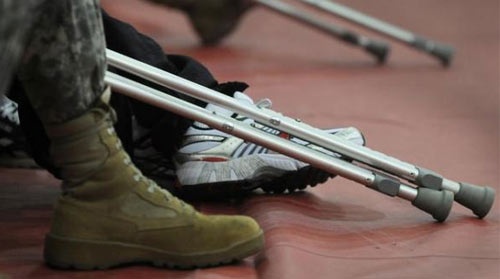Study: One in 10 U.S. veterans has no health insurance

By Peter Schurmann, New America Media
One in 10 veterans under the age of 65 is currently living without health insurance and reports not using Veterans Affairs (VA) health care, according to a new study examining health care access for retired service members.
The report, which also found a high number of veterans' family members living without insurance, notes such rates are highest in states that have made little progress in implementing provisions of the Affordable Care Act. These states account for 40 percent of uninsured veterans.
Despite having higher rates of health insurance than the general population, "an estimated 1.3 million veterans lack health insurance coverage and do not use VA health care," noted the study's co-author, Genevieve Kenney, who points out a majority of uninsured veterans tend to be younger and less well educated.
The study, released last Thursday by the non-partisan Urban Institute, comes as the nation awaits a Supreme Court decision on the fate of the ACA. A ruling is expected in June.
If upheld, about 630,000 uninsured veterans under the age of 65 would likely qualify for Medicaid, the state and federal health insurance program for the poor, which would be expanded under the law. Under current law, just one in 10 qualifies for the program.
Another 520,000 uninsured vets would be eligible for subsidized health coverage in new marketplaces, or insurance exchanges, mandated under the ACA. This would also benefit close to 80 percent of the nearly one million family members of uninsured vets.
There are currently around 13 million veterans between the ages of 19 and 64 living in the United States. Some 17 percent of those without insurance report suffering from service-related disabilities or functional limitations, while 41 percent say they have unmet medical needs. Another 34 percent say they have delayed care due to cost, the report notes.
With two wars winding down in Afghanistan and Iraq, the findings also showed that one in four uninsured veterans served between September 2001 and 2010.
The report is the first to examine rates of health insurance among veterans on both the national and state level. There are several states with more than 14 percent uninsured -- Louisiana, Oregon, Idaho and Montana. On average, uninsurance is higher among those that have "taken only limited steps toward implementing exchanges under the ACA," according to the report.
Texas and California are each home to more than 100,000 uninsured vets, the study found.
While the authors of the report say more aggressive implementation of the ACA would help ameliorate the problem, J.P. Tremblay, spokesperson for the California Department of Veterans Affairs, says the real issue is making sure vets understand the benefits available to them through the VA system.
"Many don't know," says Tremblay, who explains that when returning home, soldiers "get a week of transition services" -- meaning they sit in a class while someone lectures them on accessing benefits. The problem, he says, is that most are only thinking of one thing, and that’s "getting home."
Tremblay says the ACA is in many ways modeled after the VA system, which he describes as "top notch," adding that all returning vets are guaranteed coverage for the first five years. The challenge, he says, is "getting into the system."
Post-Traumatic Stress Disorder (PTSD) and other maladies common to service members can take time to manifest, he explains, so many put off registering. When they do experience symptoms, it can exacerbate frustrations of trying to register for the first time.
Reports of lengthy waits and delayed process times for claims have become fairly common since the start of the wars in Afghanistan and Iraq.
The Urban Institute report also suggested that proximity to a VA center could be one of the reasons explaining whether or not service members accessed the health care that was available to them. Expanded coverage through the ACA, authors contend, would provide a greater availability of options for veterans and their family members.
They do note, however, that with increased options come problems of fragmented care. Those accessing both VA and non-VA coverage, for example, may need "targeted assistance… to help them make informed choices that do not disrupt the care they have been receiving."
With uninsured veterans accounting for roughly 5 percent of the nation's 47 million people without health insurance, the study concludes, "more aggressive ACA implementation" will help ensure they get the care they need.
